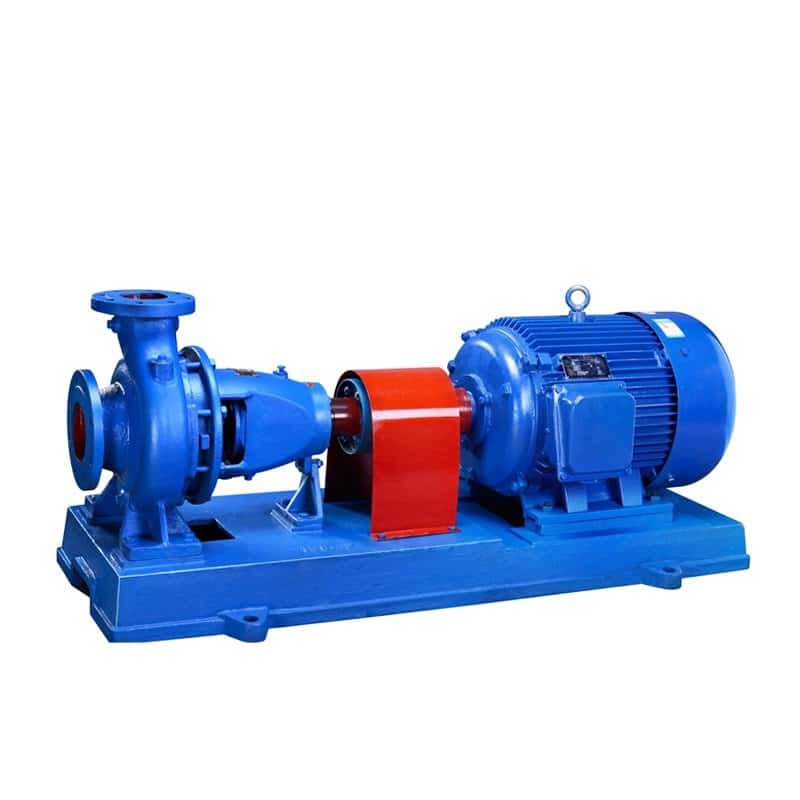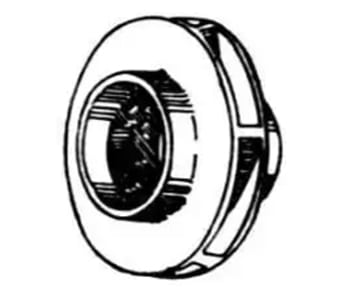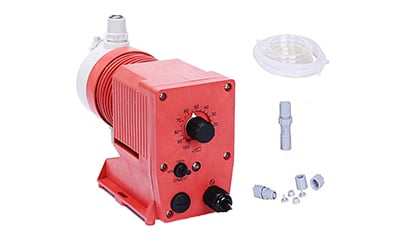What is a centrifugal pump?
A centrifugal pump is a mechanical device that moves fluid by transferring rotational energy from one or more driven rotors, called impellers. The fluid enters the rapidly rotating impeller along its axis and is discharged by centrifugal force along its circumference through the tips of the impeller’s vanes. The impeller’s action increases the velocity and pressure of the fluid and directs it toward the pump outlet. The pump casing is specifically designed to compress the fluid from the pump inlet, direct it to the impeller, and then slow and control the fluid before discharging.



How does a centrifugal pump work?
The impeller is the key component of a centrifugal pump. It consists of a series of curved vanes. These are usually sandwiched between two discs (closed impellers). For fluids with entrained solids, open or semi-open impellers (supported by a single disc) are preferred (refer to the figure below).



The fluid enters the impeller along its shaft (“eye”) and flows out along the circumference between the blades. The impeller, located on the other side of the eye, is connected to the motor via the drive shaft and rotates at high speed (typically 500-5000 rpm). The rotational motion of the impeller accelerates the fluid through the impeller vanes and into the pump casing.
There are two basic designs of pump casing: the worm casing and the diffuser. The purpose of both designs is to convert the fluid flow into a controlled discharge under pressure.
In the worm casing, the impeller is offset, effectively creating a curved funnel with a cross-sectional area that increases toward the pump outlet. This design results in an increase in fluid pressure toward the outlet (refer to the figure below).

The same basic principle applies to the diffuser design. In this case, the fluid pressure increases as the fluid exits between a fixed set of blades surrounding the impeller (refer to the figure below). Diffuser designs can be customized for specific applications and are therefore more efficient. When it is advantageous to avoid additional shrinkage of the diffuser blades, the worm gear is better suited for applications involving entrained solids or high viscosity fluids. The asymmetry of the worm housing design can lead to greater wear on the impeller and drive shaft.

What are the main features of a centrifugal pump?
There are two main pump families: centrifugal pumps and displacement pumps. Compared to the latter, centrifugal pumps are usually specified for higher flow rates and pumping low viscosity liquids down to 0.1 cP. In some chemical plants, 90% of the pumps are centrifugal pumps. However, there are many applications where positive displacement pumps are preferred.
What are the limitations of centrifugal pumps?
The efficient operation of centrifugal pumps relies on the constant high speed rotation of their impellers. For high viscosity feeds, centrifugal pumps become increasingly inefficient: resistance is greater and higher pressures are required to maintain a specific flow rate. In general, therefore, centrifugal pumps are suitable for low-pressure, high-volume, pumped liquid applications with viscosities between 0.1 and 200 cP.
Slurries such as mud or high-viscosity oils can cause excessive wear and overheating, which can lead to damage and premature failure. Volumetric pumps typically operate at fairly low speeds and are less prone to these problems.
Any shear-sensitive pumping media (emulsions, slurries or separation of biological fluids) can also be damaged by the high speed of the centrifugal pump impeller. In this case, the lower speed of the positive displacement pump is preferred.
Another limitation is that, unlike positive displacement pumps, a centrifugal pump cannot provide suction during drying: it must first be filled with the pumped fluid. Therefore, centrifugal pumps are not suitable for any application with intermittent supply. In addition, if the feed pressure is variable, a centrifugal pump will produce a variable flow rate; a positive displacement pump is not sensitive to pressure changes and will provide a constant output. Therefore, a positive displacement pump is preferred in applications where precise metering is required.
The following table summarizes the differences between centrifugal pumps and displacement pumps.
| Property | Centrifugal | Positive Displacement |
| Effective Viscosity Range | Efficiency decreases with increasing viscosity (max. 200 Cp) | Efficiency increases with increasing viscosity |
| Pressure tolerance | Flow varies with changing pressure | Flow insensitive to changing pressure |
| Efficiency decreases at both higher and lower pressures | Efficiency increases with increasing pressure | |
| Priming | Required | Not required |
| Flow (at constant pressure) | Constant | Pulsing |
| Shearing (separation of emulsions, slurries, biological fluids, food stuffs) | High speed damages shear-sensitive mediums | Low internal velocity. Ideal for pumping shear sensitive fluids |
What are the main applications of centrifugal pumps?
Centrifugal pumps are commonly used to pump water, solvents, organics, oils, acids, bases and any “thin” liquids in industrial, agricultural and domestic applications. In fact, centrifugal pumps are designed to be used in almost any application involving low viscosity fluids.
| Type of centrifugal pump | Application | Features |
| Canned motor pump | Hydrocarbons, chemicals where any leakage is not permitted | Sealless; impeller directly attached to the motor rotor; wetted parts contained in can |
| Magnetic drive pump | Sealless; impeller driven by close coupled magnets | |
| Chopper/grinder pump | Waste water in industrial, chemical and food processing/ sewage | Impeller fitted with grinding teeth to chop solids |
| Circulator pump | Heating, ventilation and air conditioning | Inline compact design |
| Multistage pump | High pressure applications | Multiple impellers for increased discharge pressures |
| Cryogenic pump | Liquid natural gas, coolants | Special construction materials to tolerate low temperatures |
| Trash pump | Draining mines, pits, construction sites | Designed to pump water containing solid debris |
| Slurry pump | Mining, mineral processing, industrial slurries | Designed to handle and withstand highly abrasive slurries |
Conclusion
Centrifugal pumps operate by transferring rotational energy from one or more driven rotors, called impellers. The impellers act to increase the speed and pressure of the fluid and direct it to the pump outlet. The centrifugal pump is simple in design and easy to operate and maintain.
The centrifugal pump design provides a simple and cost effective solution for most low pressure, high volume pumping applications involving low viscosity fluids such as water, solvents, chemicals and light oils. Typical applications include water supply and circulation in petrochemical plants, irrigation and chemical transfer. Volumetric pumps are suitable for applications involving high viscosity fluids such as thick oils and slurries, especially at high pressures, for complex feeds such as emulsions, food or biological fluids, and when precise metering is required. For more information about types of pumps, please check The classification of the pump.





